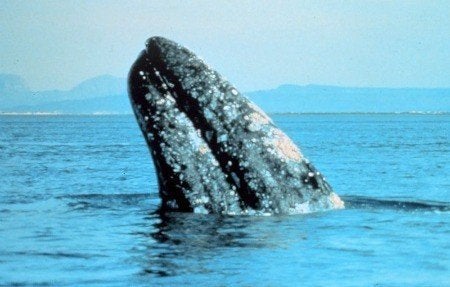The population of eastern Pacific gray whales shows a huge dip at the same point that whaling increased in the early 20th century, a new analysis of acient whale genes shows.
Eastern Pacific gray whales are a subspecies of grey whale that lives in the Pacific Ocean, migrating from the Arctic to Mexico yearly. Their population is currently estimated to be around 20,000. They are up to 46 feet (14 meters) long and weigh up to 99,000 pounds (45,000 kilograms).
While scientists have known that commercial whaling decreased whale populations, the specifics of the population prior to whaling has been uncertain. To get a better understanding of the pre-whaling numbers for one subspecies of gray whale, the researchers used DNA samples from the bones of eastern Pacific gray whales that lived between 150 and 2,500 years ago and compared the results with the genomes of modern whales.
"In this case, we were able to look at pre-whaling specimens of gray whales, and found that the genetic data are consistent with a sharp and recent bottleneck — very likely the result of commercial whaling," study researcher Elizabeth Alter, of City University of New York, York College, said in a statement.
They saw that the older whales, from before the advent of commercial whaling, had much more variation within their genomes than today's whales. This means that at the time, the whale population was much larger.
This genetic data on those whales suggests their population used to be much larger than their current numbers, probably around 78,000 to 116,000. These estimates were at odds with historical records of whale populations, the researchers said, which had suggested that there were somewhere between 15,000 and 35,500 whales at that time.
Their new study supports the previous genetic work, which focused on only current whale populations and suggested their numbers were much larger even as little as 200 years ago.
"Retrieving DNA from ancient whales allows more direct insights into their population histories than using modern DNA alone," Alter said. "As methods for retrieval and analysis of ancient DNA improve, we'll be able to increasingly refine population histories for heavily exploited species like whales."
The results were published May 9 in the journal PLoS ONE.
You can follow LiveScience staff writer Jennifer Welsh on Twitter, on Google+ or on Facebook. Follow LiveScience for the latest in science news and discoveries on Twitter and on Facebook.
Copyright 2012 LiveScience, a TechMediaNetwork company. All rights reserved. This material may not be published, broadcast, rewritten or redistributed.
Support HuffPost
Our 2024 Coverage Needs You
Your Loyalty Means The World To Us
At HuffPost, we believe that everyone needs high-quality journalism, but we understand that not everyone can afford to pay for expensive news subscriptions. That is why we are committed to providing deeply reported, carefully fact-checked news that is freely accessible to everyone.
Whether you come to HuffPost for updates on the 2024 presidential race, hard-hitting investigations into critical issues facing our country today, or trending stories that make you laugh, we appreciate you. The truth is, news costs money to produce, and we are proud that we have never put our stories behind an expensive paywall.
Would you join us to help keep our stories free for all? Your contribution of as little as $2 will go a long way.
Can't afford to donate? Support HuffPost by creating a free account and log in while you read.
As Americans head to the polls in 2024, the very future of our country is at stake. At HuffPost, we believe that a free press is critical to creating well-informed voters. That's why our journalism is free for everyone, even though other newsrooms retreat behind expensive paywalls.
Our journalists will continue to cover the twists and turns during this historic presidential election. With your help, we'll bring you hard-hitting investigations, well-researched analysis and timely takes you can't find elsewhere. Reporting in this current political climate is a responsibility we do not take lightly, and we thank you for your support.
Contribute as little as $2 to keep our news free for all.
Can't afford to donate? Support HuffPost by creating a free account and log in while you read.
Dear HuffPost Reader
Thank you for your past contribution to HuffPost. We are sincerely grateful for readers like you who help us ensure that we can keep our journalism free for everyone.
The stakes are high this year, and our 2024 coverage could use continued support. Would you consider becoming a regular HuffPost contributor?
Dear HuffPost Reader
Thank you for your past contribution to HuffPost. We are sincerely grateful for readers like you who help us ensure that we can keep our journalism free for everyone.
The stakes are high this year, and our 2024 coverage could use continued support. If circumstances have changed since you last contributed, we hope you’ll consider contributing to HuffPost once more.
Already contributed? Log in to hide these messages.
